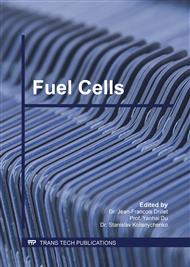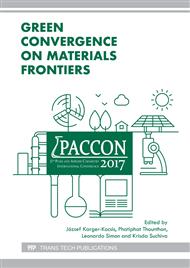p.115
p.120
p.125
p.131
p.141
p.146
p.151
p.156
p.161
Experimental Study on the Performance of DMFC Using Novel Composite Materials of Polypyrrole-Coated Polypropylene as BPs
Abstract:
Polypropylene/three-carbon-filler composite bipolar plates (BPs) of direct methanol fuel cell (DMFC) were fabricated by an injection molding. The composite materials were made of polypropylene (PP), carbon black, carbon fiber and graphite. Gas flow channel surfaces on the BPs were subsequently modified by polypyrrole (PPy) using a coating technique in order to improve surface electrical conductivity. This research is a feasibility study to use PPy-coated PP composite as BPs in a DMFC. The surface electrical resistance and performance in a fuel cell containing the composite BPs under DMFC operating conditions were evaluated against conventional graphite BPs. The surface resistance values of PPy-coated PP composites decreased around six orders of magnitude, compared with those values of PP composites. According to the performance results, PPy-coated composite BPs can be used in DMFC if the surface adhesion between a PPy layer and the BP surface was further improved.
Info:
Periodical:
Pages:
141-145
Citation:
Online since:
October 2017
Price:
Сopyright:
© 2017 Trans Tech Publications Ltd. All Rights Reserved
Share:
Citation:



